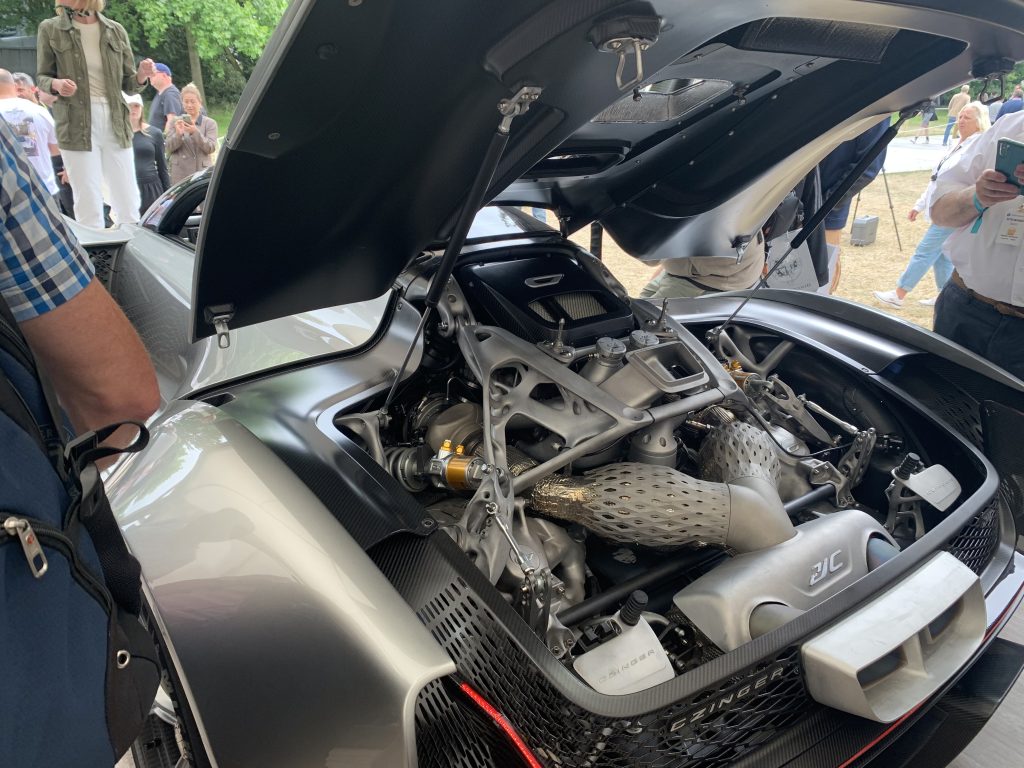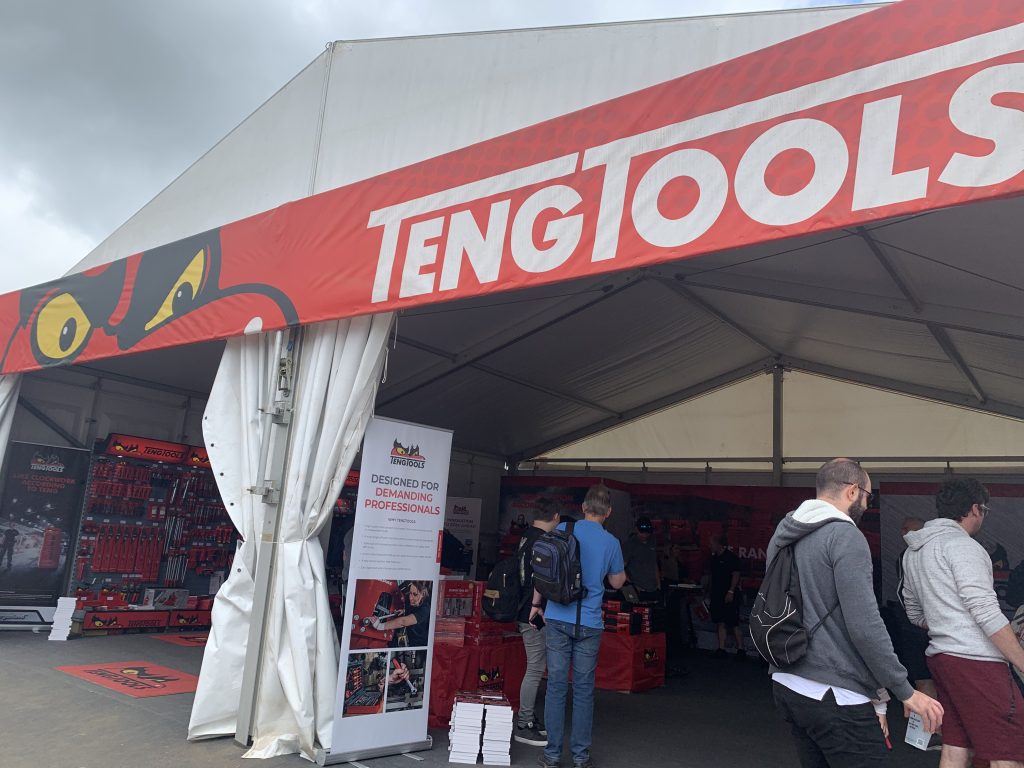With the 2022 Goodwood Festival of Speed now in full swing, motoring enthusiasts from around the world have begun descending on rural Southern England.
Already at the historic hill climb, exhibitors have showcased a plethora of parts that reflect 3D printing’s growing efficacy in addressing automotive needs, ranging from tooling to motorbike components. However, it’s Czinger Vehicles’ UK debut of the 21C, a 1,250 horsepower largely-3D printed hypercar, that has really stolen the show.
Speaking to 3D Printing Industry at the event, the firm’s Founder Kevin Czinger has revealed the full extent of its adoption of the Divergent Adaptive Production System (DAPS) developed by his other business, Divergent Technologies, for the first time.
Czinger explained how the 21C’s chassis and suspension is almost entirely-3D printed, and in future, he plans to use DAPS to realize greater part consolidation.
“If you look at the chassis itself, almost all the frame structure is designed, printed and assembled using DAPS,” explained Czinger. “As is the entire suspension system, except things like shock absorbers, that’s all 3D printed. I’d say the induction and exhaust elements of the engine, they’re all 3D printed as well. What I would add is, this is the first stage of this type of 3D printing, what you’ll see at a more advanced stage, is the taking of two different subsystems to create one unified system.”

The Czinger 21C’s Goodwood debut
Ahead of this year’s Festival of Speed, Czinger Vehicles managed to capture an unprecedented amount of media attention, for an automotive 3D printing firm at least. The 21C’s run-out at the Laguna Seca race track, where it’s reported to have broken the lap record for production cars, only served to build intrigue around a car that pairs a futuristic design with a suitably advanced manufacturing process.
While the famous Goodwood hill climb is lined with hay bales, that make maxing-out the 21C’s performance there almost impossible, Czinger Vehicles has still managed to debut it there without incident. What’s more, Czinger explained that the vehicle’s hill runs are only the start for DAPS, and its unique setup could soon unlock performance gains that simply aren’t possible on conventionally-built cars.
“At a more advanced stage, we’ll start to see the ‘functional integration’ of brake nodes, combining the upright of the front of the suspension and the brake caliper,” claimed Czinger. “That will reduce the mass of the combined structures by 40%. Imagine you’re reducing two major subsystems by 5kg or more per corner, you’re able to optimize structures, and also increase stiffness by about 30%.”
Following the 21C’s successful outing, which Czinger himself described as going “super well,” he went on to suggest that the future of DAPS may not be that far in the future. Although the entrepreneur wouldn’t be drawn on what his firm’s next vehicle will look like, he did reveal that it plans to continue creating “constantly path-breaking cars,” with its latest set to be unveiled at Pebble Beach in August 2022.

Prototyping still proving prevalent
While the 21C has no doubt been Goodwood’s highest-profile 3D printing application, exhibitors elsewhere at the event have made it clear that the technology continues to primarily be used for prototyping within automotive.
One of the exhibitors, Teng Tools, may not have 3D printing engineers at the hill climb, or even use the technology in the UK, but its team has suggested that it’s deployed at the firm’s Swedish HQ. Since installing its first 3D printer in 2018, the company has found it easier to create ergonomical tooling prototypes, both for in-house and customer usage.
Ohlins, which itself announced the adoption of Exmet 3D printing back in 2013, also opened up on its utilization of the technology at the event. According to its MTB Sales and Marketing manager Alex Boyle, the firm 3D prints parts like fitting forklets and prototype cylinder head gaskets, though he added that the introduction of a new machine tooling shop has somewhat curtailed its activities in these areas.

Elsewhere, Thornton Hundred Motorcycles revealed that it not only deploys 3D printing, but 3D scanning as well, in the production of custom motorbike parts. Alex Minshall, a design engineering manager at the firm, explained in its exhibiting area how the technologies help ensure the end-quality of its products, and develop those that drive performance, such as thermally-optimized supercharger casings.
“We do a lot of supercharger work, where we take off the stator case on the crank to integrate a pulley that spools up the supercharger. These are super high-tolerance parts,” said Minshall. “With 3D scanning, we also do clearances for parts like passenger seats, where there’s a lot of moving parts. It allows us to start the CAD off, in that way you don’t have to do multiple measurements.”
“We have an Ultimaker too that we run prototypes on constantly. It’s an absolute workhorse,” he added. “It’s got the material station underneath it as well, which allows us to operate with multiple materials like nylons, but we pretty much operate with tough PLA, and use PVA for structures sometimes. It’s a cost-cutting exercise for us… and it allows us to reduce our waste, as we’re quite environmentally-oriented.”

Running up that hill with 3D printing
Over in the garage area, a number of other manufacturers were displaying vehicles with performance-enhancing 3D printed parts, showing that Czinger Vehicles isn’t the only one innovating with the technology. The F1 world champion Jenson Button-backed Radford showcased its reimagining of the Lotus Type 62-2 at the event, complete with more than 500 Stratasys Direct-3D printed components.
Manufacturers such as Mercedes also debuted vehicles with previously-unseen 3D printed parts at Goodwood, including its Vision EQXX concept car. The all-electric motor, which recently managed to travel a record-setting 1,202 km on a single charge, is said to feature several naturally-inspired printed components, designed to yield weight savings of 15-20% without compromising on reliability.
Likewise, BMW debuted its new 503 bhp 2023 M3 Touring at the event, by subjecting it to the famed hill climb course. Driven by the Duke of Richmond no less, the estate car, complete with a 3D printed lip spoiler installed above its rear windscreen, swept up the track without incident, despite encountering wet weather conditions.
To stay up to date with the latest 3D printing news, don’t forget to subscribe to the 3D Printing Industry newsletter or follow us on Twitter or liking our page on Facebook.
For a deeper dive into additive manufacturing, you can now subscribe to our Youtube channel, featuring discussion, debriefs, and shots of 3D printing in-action.
Are you looking for a job in the additive manufacturing industry? Visit 3D Printing Jobs for a selection of roles in the industry.
Featured image shows the start/finish line at the Goodwood Festival of Speed. Photo by Paul Hanaphy.



